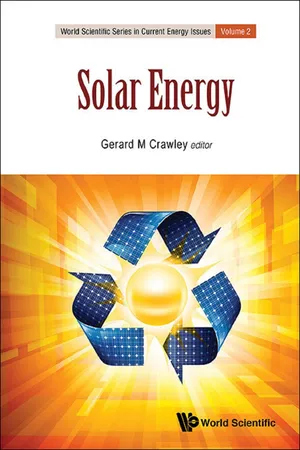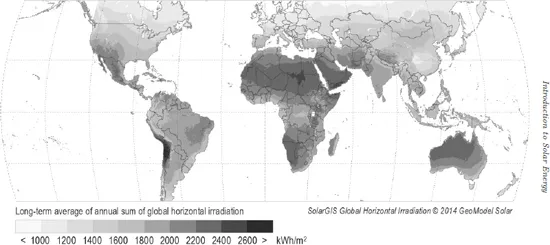![]()
Chapter 1
Introduction to Solar Energy
R. Corkish,*,† W. Lipiński‡ and R. J. Patterson*
*University of New South Wales, Sydney 2052, Australia
†Australian Centre for Advanced Photovoltaics, Sydney 2052, Australia
‡The Australian National University, Canberra 2601, Australia
This chapter introduces the sun as our planet’s principle and sustainable energy source, noting its main relevant characteristics, and the history as well as pros and cons of its energetic use. It gives a high-level overview of the various solar energy capture and conversion technologies discussed in the book and summarizes the economics and policy aspects.
1 What is Solar Energy?
The sun drives 99.98% of the world’s energy supply,1 including thermal, photovoltaic, photochemical, photobiological and hybrid solar, hydro, wind, wave, and biomass energy conversion. It originally grew the biomass that we now access as fossil fuels. Other sources include tidal, geothermal and nuclear.1 The sun’s energy comes from fusion reactions in its core. These reactions have been “burning” for 4.5 billion years and are expected to continue for another 6.5 billion years. The total power radiated out into space by the sun is about 3.86 × 1026 W. Since the sun is approximately 1.5 × 1011m from the earth, and because the earth is about 6.3 × 106m in radius, it intercepts only 0.000000045% of this power.2 This still amounts to a massive 1.75 × 1017 W.
Most of this radiation is in the visible and infrared part of the electromagnetic spectrum, with less than 1% emitted in the radio, UV and X-ray spectral bands.
The sun’s electromagnetic radiation approximates that of a black body with a temperature around 5778 K, with its peak in the yellow range of the visible spectrum. This is sometimes “rounded up” to 6000K for simplicity.3
Fig. 1. The AM0 spectrum of solar radiation, as would be observed at the top of the earth’s atmosphere. The spectral irradiance is shown as a function of photon wavelength (left) and photon energy (right). The spectral regions are indicated. Image credit: Prof. Pietro Altermatt.5
Figure 1 shows the spectrum of radiation from ultraviolet to infrared, as seen outside the earth’s surface. This standard “AM0” spectrum4 is that used to model and predict and qualify solar cells for use in space. The “AM” in the name refers to the “air mass”, the thickness of terrestrial atmosphere through which the radiation has passed before it is observed, in this case zero.
The solar radiation that reaches the earth is reduced in intensity and the spectrum is changed by absorption and scattering as it passes through the atmosphere, and by reflection from the surface.6 Scattering means that radiation reaches a receiver not only directly from the visible solar disk but also from the rest of the sky. Standard spectra and models have been derived for use in simulations and estimations.7 For example, tables presented in ASTM Standard G1738 are commonly used to represent terrestrial solar radiation in two forms (see Fig. 2):
1.AM1.5D: Direct Normal Incidence radiation is that received on earth directly from the solar disk, as would be received by a concentrating collector. The total integrated irradiances for the standard direct spectrum is 900.1 Wm−2;
2.AM1.5G: Hemispherical on 37° Tilted Surface radiation adds the direct radiation and the scattered diffuse radiation to yield the hemispherical or global radiation, impinging on a sun-facing 37°-tilted surface, useful for modeling flat plate (non-concentrating) collectors. The total integrated irradiances for the standard hemispherical tilted spectrum is 1000.4 Wm−2.
Fig. 2. AM1.5 global (AM1.5G) and direct normal (AM1.5D) standard terrestrial solar and their relative difference as a function of wavelength. Image credit: Prof. Pietro Altermatt.11
Note that there are many narrow and broad notches9 in these spectra, resulting from absorption by particular atmospheric gas and vapor molecules. The atmosphere is opaque to ultraviolet radiation with wavelengths less than approximately 300 nm due to absorption by molecules such as H2, O2, and N2. In the near-UV spectral range the main absorber is ozone, which also impacts on the visible range (380–780nm), as do NO2 and water vapor. Water vapor also introduces several broad absorption bands in the infrared range and carbon dioxide and oxygen also have an effect.10
The long-term average of the total solar irradiance at the average distance of the earth’s orbit, one Astronomical Unit of 1.4959787066 × 1011 m, is called the solar constant, S. Its reference value12 is 1366.1 Wm−2.
Actually, the “solar constant” is not constant but varies by ±3% due to the earth’s elliptical orbit. There is an additional variation of about ±0.1% in the solar constant which is due to a variation in the total luminosity of the sun itself over the 11-year solar cycle. Researchers have tried to model this variation over the last 400 years by correlation with recorded sunspot numbers, suggesting that the sun may have varied in its power output by up to 1%.2
When diurnal and seasonal variations are taken into account, approximately 342 W is available for every square meter of earth’s surface.13 This equates to an annual energy input14 of 5.46 × 1024 J. About 29% is reflected back to space by clouds, atmospheric particles or ground surfaces. About 23% of intercepted solar energy is absorbed in the atmosphere and 48% passes through to be absorbed by the surface.15
The geographical distribution of solar radiation reaching the earth’s surface is studied and monitored extensively and satellite-derived estimates are available for the whole globe.16 Detailed mapping resources for USA and Australia, for example, are provided by the National Renewable Energy Laboratory17 and the Bureau of Meteorology.18 Free online maps for the world and many of its regions are provided by SolarGIS.19
As might be expected, there tends to be less solar radiation towards the poles and cloudiness around the equator reduces the radiation reaching the ground there, leading to the regions of highest insolation being found in the high tropical and low temperate latitudes.
Measurements of solar radiation are made at many sites globally20 with calibrated pyrheliometers,21 the most sophisticated of which use shadow bands to measure separately the diffuse and direct components. Historical data and long-term averages are available through various databases, including the World Radiation Data Centre22 and the World Radiation Monitoring Center (WRMC), which maintain the central archive of the Baseline Surface Radiation Network (BSRN).23 The directly measured data is of limited use to engineers to design solar energy collection systems and it undergoes considerable processing to generate useful formats such as typical meteorological year (TMY) or monthly average daily global radiation on a horizontal surface.24
Additionally, solar radiation is estimated from satellite-based instruments.25,26 For example, the NASA Atmospheric Science Data Center16 provides long-term estimates of surface solar energy flux for 1° longitude by 1° latitude grid covering the entire globe. The data is readily accessible via the freely available RETScreen Clean Energy Management Software system.27
2 Advantages and Disadvantages Associated with Solar Energy Use
Solar energy has several major advantages when compared with other sources. The resource is distributed, though unequally, to every location on the globe. The resource is abundant, to the extent that many countries have far more than they need to supply their energy needs from solar alone. It is effectively renewable on a human timescale, since the sun is expected to maintain similar production of its essential radiation at about the current rate for billions of years before eventually cooling to become a red giant.28
Fig. 3. Global solar radiation over the land surfaces of the world. Reprinted with permission from SolarGIS Global Horizontal Irradiation © 2014 GeoModel Solar.
Arguably, untraded solar energy already dominates the global energy supply as it grows our forests and crops that provide basic energy services to a large fraction of the world’s population, warms our passive solar buildings, evaporates seawater to produce our industrial salt supply and even dries our crops, clothes and fuels outdoors.
Collection and conversion to various useful energy forms is generally quiet and clean, with little or no local pollution from operation, including greenhouse gas pollution. Solar energy generall...



